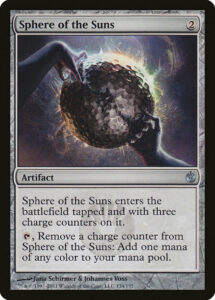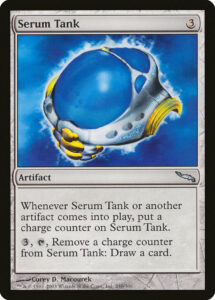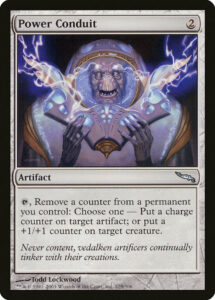Some designs draw from deep veins, where there are an abundance of ancestors that led to its precise iteration. These are cards like Inspiring Overseer, one of a long line of cantripping creatures, or Silver Bolt, a style of design that has become a mainstay fairly recently. Noble’s Purse is different in that it has one extremely clear antecedent: Sphere of Suns.

Blatant Thievery can be a good thing
Noble’s Purse is a strictly better version of Sphere of the Suns. Both are two-mana artifacts that enter the battlefield tapped, both ramp and fix, and only function thrice. But Noble’s Purse allows you to charge up mana across turns (plus generate bonus artifacts), functionality that Sphere of the Suns simply lacks.
It’s not surprising for Sphere of the Suns to be outclassed. It was printed over a decade ago, for one. While it’s dangerous for Standard to have a two-mana mana rock, Commander is a format with Orzhov Signet and friends, Fellwar Stone, Mind Stone, and the unbeatably strong Arcane Signet—it’s absolutely safe to outclass Sphere of the Suns in Commander.

Charging up, down, and around
While there’s a very clear line between Sphere of the Suns and Noble’s Purse, there’s a rich tapestry of artifacts employing charge counters. Way back in Legends, cards like White Mana Battery let you charge them up and then wind them down for value—a play pattern that would be soon be repeated on cards like Dwarven Hold and Jeweled Amulet.
A decade later, Mirrodin block played heavily with charge counters, using cards like Altar of Shadows and Banshee’s Blade (which simply grew in number of counters and scale of effect), Clearwater Goblet (with a variable effect which became fixed upon casting), and Infused Arrows (which followed Serrated Arrows by having a finite number of uses). This last style, decrementing cards, was employed heavily in Scars of Mirrodin block. There it was used in a cycle of five Trigons along with Necrogen Censer, Shriekhorn, Tumble Magnet, and the highly specific Surge Node (to name several).
Decrementing cards are the oddest use for charge counters, as they tease the user with their expiration date. There’s just something that feels worse about having a now-useless artifact linger as opposed to having a spent spell in your graveyard.
It made sense for Scars of Mirrodin block to rely so heavily on decrementing charges—it matches the feel of a world falling to evil. And it made sense for the same to happen in Hour of Devastation, when that world also fell to evil. But as just discussed, there’s good reason we hardly see cards like that anymore.
Nowadays, the few we do see are like Mazemind Tome, which collects its garbage and vanishes (although weirdly, the Tome counts upwards rather than down), and Reckoner Bankbuster, which gives you a prize for your efforts and leaves behind a very relevant vehicle. Energy allows for the same kinds of decrementing designs, but instead of each card being a closed systems with finite uses (barring effects like Proliferate and Surge Node), every card is aspirational because energy charges everything. Noble’s Purse is so notable because we rarely see the simple, finite use version of this effect anymore without a prize at the end.

In an age where cards are wordier, it’s especially nice to see simple, staple versions of effects. Sure, Noble’s Purse calls back to a style of design that’s mostly been left in the past, and rightly so. But just because we shouldn’t see cycles of Trigons and six other decrementing designs anymore doesn’t mean a single one can’t do great work in a format.
Being reminded of all the ways that charge counters (and their fellows, like brick counters) continue to be remixed makes me excited about all the ways we’ll see them used in the future. I want to see more cards like Reckoner Bankbuster and Mazemind Tome that have a quest reward for completing them but break from the mold of card draw engine. Imagine a Serrated Arrows, Tumble Magnet, or even a Sphere of the Suns that pops into something awesome like the brick counter cards from Amonkhet did, rather than merely linger. I’m certain we’ll see more of them, as Magic is a hungry beast that’s making more cards now than ever before.
And, as always, thanks for reading.
Zachary Barash is a New York City-based game designer and the last commissioner of Team Draft League. He designs for Kingdom Death: Monster, has a Game Design MFA from the NYU Game Center, and does freelance game design. When the stars align, he streams Magic (but the stars align way less often than he’d like).

